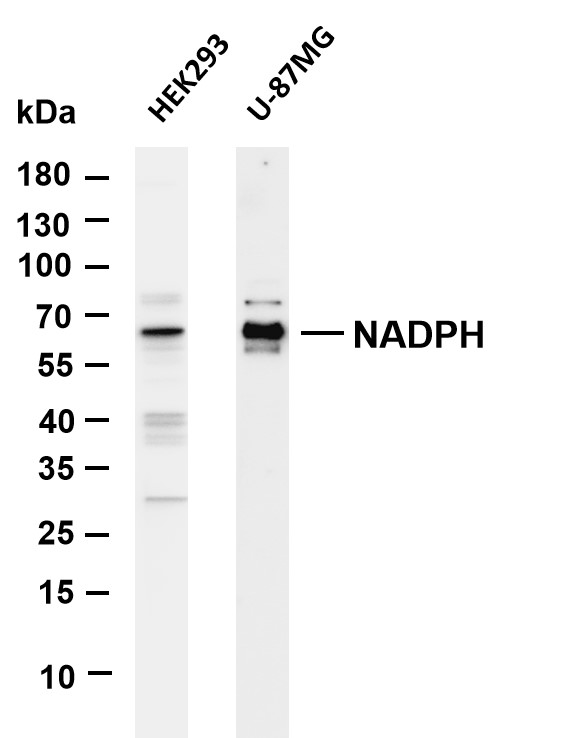NADPH oxidase 4 (PT0181R) PT® Rabbit mAb
- Catalog No.:YM8112
- Applications:WB;IF;IP;ELISA
- Reactivity:Human; Mouse; Rat;
- Target:
- NOX4
- Fields:
- >>AGE-RAGE signaling pathway in diabetic complications;>>Alcoholic liver disease;>>Alzheimer disease;>>Pathways of neurodegeneration - multiple diseases;>>Chemical carcinogenesis - reactive oxygen species
- Gene Name:
- NOX4 RENOX
- Protein Name:
- NADPH oxidase 4 (EC 1.6.3.-) (Kidney oxidase-1) (KOX-1) (Kidney superoxide-producing NADPH oxidase) (Renal NAD(P)H-oxidase)
- Human Gene Id:
- 50507
- Human Swiss Prot No:
- Q9NPH5
- Mouse Swiss Prot No:
- Q9JHI8
- Rat Swiss Prot No:
- Q924V1
- Specificity:
- endogenous
- Formulation:
- PBS, 50% glycerol, 0.05% Proclin 300, 0.05%BSA
- Source:
- Monoclonal, rabbit, IgG, Kappa
- Dilution:
- WB 1:1000-5000,IF 1:200-1000,ELISA 1:5000-20000,IP 1:50-200
- Purification:
- Protein A
- Storage Stability:
- -15°C to -25°C/1 year(Do not lower than -25°C)
- Molecular Weight(Da):
- 67kD
- Observed Band(KD):
- 67kD
- Background:
- This gene encodes a member of the NOX-family of enzymes that functions as the catalytic subunit the NADPH oxidase complex. The encoded protein is localized to non-phagocytic cells where it acts as an oxygen sensor and catalyzes the reduction of molecular oxygen to various reactive oxygen species (ROS). The ROS generated by this protein have been implicated in numerous biological functions including signal transduction, cell differentiation and tumor cell growth. A pseudogene has been identified on the other arm of chromosome 11. Alternative splicing results in multiple transcript variants.[provided by RefSeq, Jan 2009],
- Function:
- developmental stage:Expressed in fetal kidney and fetal liver.,enzyme regulation:Inhibited by plumbagin (By similarity). Activated by phorbol 12-myristate 13-acetate (PMA). Activated by insulin. Inhibited by diphenylene iodonium.,function:Constitutive NADPH oxidase which generates superoxide intracellularly upon formation of a complex with CYBA/p22phox. Regulates signaling cascades probably through phosphatases inhibition. May function as an oxygen sensor regulating the KCNK3/TASK-1 potassium channel and HIF1A activity. May regulate insulin signaling cascade. May play a role in apoptosis, bone resorption and lipolysaccharide-mediated activation of NFKB. Isoform 3 is not functional. Isoform 4 displays an increased activity while isoform 5 and isoform 6 display reduced activity. May produce superoxide in the nucleus and play a role in regulating gene expression upon cell stimulation.,induc
- Subcellular Location:
- Cytoplasm
- Expression:
- Expressed by distal tubular cells in kidney cortex and in endothelial cells (at protein level). Widely expressed. Strongly expressed in kidney and to a lower extent in heart, adipocytes, hepatoma, endothelial cells, skeletal muscle, brain, several brain tumor cell lines and airway epithelial cells.
The mechanism of mulberry leaves against renal tubular interstitial fibrosis through ERK1/2 signaling pathway was predicted by network pharmacology and validated in human tubular epithelial cells. PHYTOTHERAPY RESEARCH 2019 Jun 17 WB Human 1:400 HK-2 cell
Nrf2-mediated redox balance alleviates LPS-induced vascular endothelial cell inflammation by inhibiting endothelial cell ferroptosis Scientific Reports Hou Huimin WB Human 1:1000 Human umbilical vein endothelial cells (HUVEC)
- June 19-2018
- WESTERN IMMUNOBLOTTING PROTOCOL
- June 19-2018
- IMMUNOHISTOCHEMISTRY-PARAFFIN PROTOCOL
- June 19-2018
- IMMUNOFLUORESCENCE PROTOCOL
- September 08-2020
- FLOW-CYTOMEYRT-PROTOCOL
- May 20-2022
- Cell-Based ELISA│解您多样本WB检测之困扰
- July 13-2018
- CELL-BASED-ELISA-PROTOCOL-FOR-ACETYL-PROTEIN
- July 13-2018
- CELL-BASED-ELISA-PROTOCOL-FOR-PHOSPHO-PROTEIN
- July 13-2018
- Antibody-FAQs
- Products Images

- Various whole cell lysates were separated by 4-20% SDS-PAGE, and the membrane was blotted with anti-NADPH (PT0181R) antibody. The HRP-conjugated Goat anti-Rabbit IgG(H + L) antibody was used to detect the antibody. Lane 1: HEK293 Lane 2: U-87MG Predicted band size: 67kDa Observed band size: 67kDa



